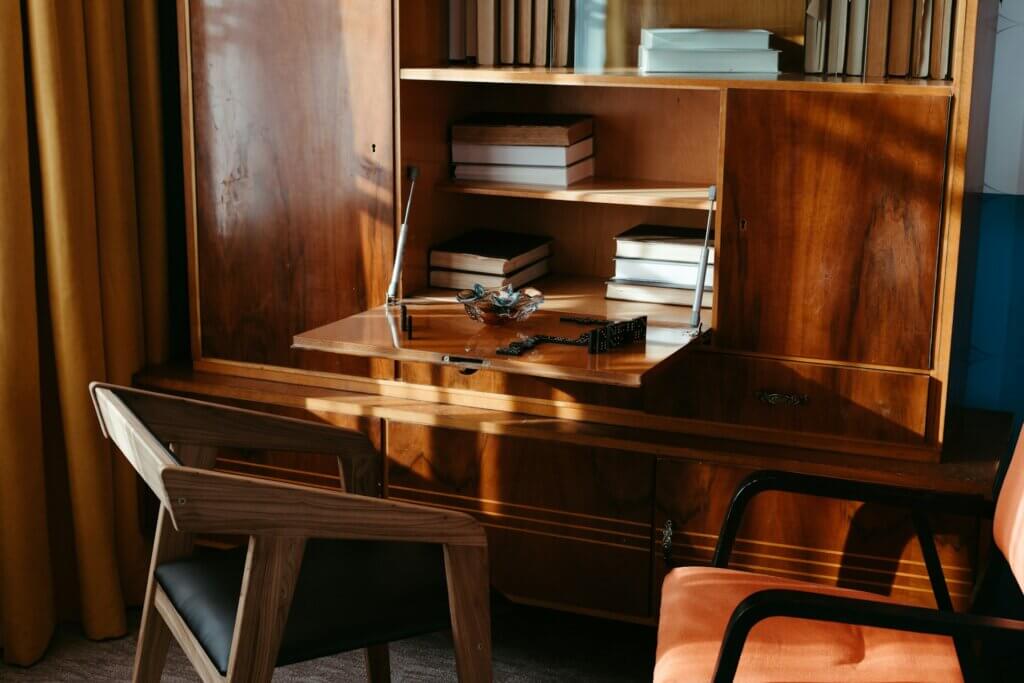- Blog
-
For Sellers
How to turn furniture flipping into a profitable venture?
Turning curbside finds into cash is all about picking smart, flipping fast, and finding buyers who’ll pay for your style.

Your neighbor just posted another jaw-dropping before-and-after photo of a thrift store dresser transformation on social media. The comments are flooding in: “Where did you get this?” and “Can you make one for me?” Sound familiar?
Here’s what most people don’t realize about furniture flipping: it’s not just about having a creative eye or knowing how to wield a paintbrush. The real money comes from understanding which pieces are worth your time, where to find them consistently, and how to reach buyers who’ll pay premium prices for your work.
This guide covers everything from finding undervalued pieces to maximizing your profit margins—turning what could be an expensive hobby into a legitimate income stream.
Why flipping furniture is a lucrative side hustle
Furniture flipping transforms used or old furniture into attractive, functional pieces that sell for profit. Furniture flippers restore or refurbish used pieces to enhance their appearance, adding value to them so they can be sold at a much higher price than they would’ve fetched.
In 2022, furniture restoration exploded in popularity on social media. In TikTok alone, #furnitureflip garnered 4.6 billion total views in 2022. This heightened interest in flipped furniture is just one of the many reasons why furniture flipping is gaining traction as a lucrative side hustle.
Here are other reasons to motivate you:
Low startup cost
Compared to many other business ventures, furniture flipping has a low startup cost. If you have good furniture at home that you can flip, the only amount you’d need to shell out will be for cleaning and refurbishing materials. No matter how small your available capital is, there is an old or neglected piece of furniture you can start with.
Flexible schedule
As a side hustle, furniture flipping does not require a set schedule. You can work on the furniture any time you’re free. This gives you plenty of flexibility when juggling family responsibilities, full-time job demands, and other commitments.
Great potential for huge returns
When done right, furniture flipping can generate substantial profits. You can purchase undervalued or neglected pieces at extremely low prices, transform them into one-of-a-kind pieces, and sell them at a large profit margin.
You’d be surprised at how much money buyers are willing to shell out for flipped furniture. In fact, statistics show that consumer spending for secondhand house goods and furniture will reach $23.56 billion in 2025. The potential for earning a significant return on your investment becomes even higher when you have an eye for design and a skill for craftsmanship.
Positive market outlook
The market for used furniture is thriving. Straits Research projects the global off-the-shelf secondhand furniture market to reach $58.58 billion by 2030—a 7.80% CAGR growth within ten years. By tapping into this growing market, you can take advantage of the demand and generate consistent sales.
Getting started with furniture flipping
To turn furniture flipping into a profitable venture, you need to equip yourself with the proper knowledge, skills, and tools. Start with thorough research to understand the market and learn to spot profitable opportunities. Educate yourself about different furniture styles, refurbishing techniques, and market trends.
Take advantage of online resources such as videos, tutorials, and free courses to learn different techniques. You can also check for workshops or community events focused on furniture making or restoration in your area. Engage in forums or online communities to learn from more experienced furniture flippers.
As you prepare for your first project, create a dedicated workspace where you can work on refurbishing furniture. If you plan to pursue furniture flipping in the long term, consider investing in sturdier tools and materials that can also be used for future projects. Strive to build a network of suppliers and artisans you can partner with once your furniture-flipping venture succeeds.
Make sure you also set a budget for your initial project. By allocating your resources well and making calculated purchasing decisions, you can maximize your potential gains and avoid unnecessary losses. While it may be tempting to dive in headfirst with multiple projects or plenty of materials, starting small allows you to gain experience and confidence at a more comfortable pace before scaling your operations.
How to choose the type of furniture to flip and sell
Now that you’ve prepared yourself and your workspace, it’s time to choose furniture to flip. Practically any furniture can be refurbished and sold, but you might want to consider the following factors to gain profits.
Space availability
Choose furniture you can easily transport using your own vehicle and work on using the available space in your garage or home. This avoids incurring any additional costs from renting a truck or storage space. Obviously, you’ll need a much bigger area for couches, tables, dressers, and chaise lounges. However, smaller furniture like ottomans, nightstands, end tables, coffee tables, and chairs can fit in a sedan, SUV, or any regular car.
Market demand
Research popular furniture styles and trends to understand what potential buyers are seeking. Look for pieces that have high demand and are likely to sell quickly.
In the latest Statista Furniture Report, the largest segments are living room furniture, bedroom furniture, and kitchen & dining furniture. Trends for secondhand furniture are pretty much the same, with living room furniture being the highest contributor to the global off-the-shelf second-hand furniture market.
If you want to check recent trends, check out Facebook Marketplace or Amazon to see what types of furniture are selling best in your area.
Tools and equipment at hand
Assess the tools and equipment you currently have or are willing to invest in. Choose furniture that can be refurbished or restored with your available resources.
If you have limited tools, look for used items in reasonably good condition or with minimal wear. These do not require much fixing and can be easily cleaned and painted with a basic toolset.
Design and material of furniture
Consider the condition of the furniture and its potential for restoration. Look for well-built pieces with timeless designs that can be improved with a modern makeover.
Focus on pieces with sturdy construction and quality craftsmanship, as they are more likely to attract buyers and fetch better prices. In terms of material, furniture made from real wood will naturally hold more value than flimsy MDFs or plastics. Keep an eye out for oak, maple, mahogany, teak, cypress, rosewood, and other premium hardwood.
Your handyman skills
Be realistic about your skills and abilities when selecting furniture to flip. Choose furniture that you can confidently restore and refurbish based on your current level of expertise.
If you’re not particularly handy, start with used furniture that only needs minor repairs. This will help you avoid spending too much time and effort on a single furniture flip. As you gain more experience and improve your skills, you can work on more complicated projects with higher potential returns.
Where to find furniture for flipping
Sourcing furniture for flipping requires a bit of legwork and much luck. You can explore many different avenues to find quality pieces suitable for refurbishing. Here are some of the best ones to check out:
- Your own home. You don’t have to go far. Take a look in your garage, basement, or attic. Check if there are furniture pieces you no longer use or would like to get rid of. Spruce them up, then list them for sale.
- Family and friends. Ask around if there’s anyone looking to declutter their home. Offer to help them by taking unwanted furniture off their hands. Often, you’ll be able to get these pieces at low cost or even for free.
- Online platforms. Social media networks, digital marketplaces, and ecommerce sites can be excellent sources for used furniture. Facebook Marketplace, eBay, Amazon, Craigslist, and Instagram have a diverse range of furniture listings, both free and for sale. You can also check out Chairish, Letgo, Nextdoor, and OfferUp.
- Physical locations. There’s bound to be a hidden gem in your neighborhood. Check out garage sales, flea markets, antique fairs, and thrift stores near you. Keep an eye out for estate sales, auctions, and liquidation sales. Ensure you also regularly check your community bulletin board and local ads to get first dibs on secondhand furniture listed for sale.
The basics of furniture restoration and refurbishment
Start by having your tools, materials, and equipment ready. Some of the basics that should be in every furniture flipper’s toolbox are:
- Paint stripper, sandpaper, a sanding block, and/or electric sander for removing scratches and old finishes
- Brushes, paint, and painter’s tape for applying new colors
- Screwdriver, drill, pliers, hex key, and other tools for removing and adding new hardware
- Finishing oil and polyurethane to protect and polish surfaces
Once you have everything prepared, follow these general steps for furniture flipping. Keep in mind that each restoration is unique and may require specific treatment case by case, but the overall process remains the same:
- Inspect and clean. Assess the condition of the furniture and thoroughly clean it. Wipe, vacuum, and use sanitizers to ensure a clean surface. Wash wood furniture with mild dish soap, warm water, and a sponge or brush. If it needs deep cleaning, use a wood cleaner. For fabric upholstery, use a fabric cleaner, stain, odor remover, and a sanitizing freshener. If the furniture has removable covers, consider throwing them in the wash.
- Repair and restore. Once clean, the furniture will be easier to examine for areas that need patching or fixing. Use appropriate tools and techniques to address any damages or weaknesses. Fix any structural issues and try to restore the furniture to its original state or as close to it as possible. You can also get creative and give it a whole new look function.
- Strip and prepare the surface. Strip old finishes using a paint stripper or other suitable methods. Sand down the surface to smoothen it and remove imperfections. An electric sander would be helpful here, but if you don’t have one, a sanding block will do. It will require some elbow grease but will still get the job done.
- Refinish and paint. Apply new finishes, paint, or a stain to enhance the furniture’s appearance. When choosing a paint or stain, make sure the color complements the overall design and style. Use brushes and painter’s tape to achieve clean lines and a professional finish.
- Add new hardware. Upgrade the look of the furniture by polishing or changing drawer pulls, knobs, and other hardware. Improving or replacing a piece’s hardware can give it a fresh and updated appearance. Alternatively, quirky choices can give an old furniture piece a new funky personality.
- Polish. To achieve an even more polished and finished look, use finishing oil and/or a protective topcoat. Apply a thin layer to the furniture surface, following the manufacturer’s instructions. This step adds shine and smoothness while protecting the piece.
Remember to double-check everything to ensure a potential buyer’s satisfaction and increase the likelihood of repeat purchases. By following these steps and paying attention to detail, your restored furniture can fetch a good profit.
Where to sell flipped furniture
There are several online and offline options where you can sell flipped furniture. You can start by spreading your new venture through word of mouth among your family, friends, and acquaintances.
Ask them to share your details and offerings with people they know who might be interested in flipped furniture. Recommendations and referrals can be powerful in generating leads and building a customer base from scratch.
Beyond your personal network, here are some of the best places to reach potential buyers and showcase your unique pieces.
Flea markets and craft fairs
Rent a booth or space at local flea markets, craft fairs, or community events. These venues provide excellent opportunities to showcase your flipped furniture, engage directly with buyers, and make sales on the spot. The unique and curated nature of these events often attracts individuals looking for distinctive and repurposed pieces.
Local consignment shops
Collaborate with consignment stores that specialize in selling refurbished furniture. These stores often have a dedicated customer base actively seeking one-of-a-kind and upcycled pieces. Partnering with them also provides you with a physical location to display and sell your furniture while reaching local buyers who are more likely to appreciate your craftsmanship.
Social media platforms
Create a strong presence on social media platforms like Facebook, Instagram, and TikTok. Establish dedicated accounts for your furniture flipping business and regularly post high-quality images and engaging content.
Utilize relevant hashtags to increase visibility and interact with your followers to build a community around your brand. You can also leverage social media platforms’ marketplace features, such as Facebook Marketplace, to directly reach potential buyers in your local area.
Online marketplaces
Utilize popular online platforms such as Amazon, Etsy, eBay, Craigslist, and OfferUp. These platforms provide a vast reach and allow you to connect with a broader audience of buyers specifically looking for refurbished furniture pieces. Listing your pieces on Amazon in particular can help boost your online visibility—especially with the platform ranking second as the top source of pre-purchase information.
Maximize the exposure of your flipped furniture by utilizing a combination of these online and offline selling channels. Remember to tailor your approach to each platform and build engagement with people who appreciate the value and craftsmanship of refurbished pieces.
Tips for Furniture Flipping Success
All set for furniture flipping? Here are some more tips to attract more buyers and build a profitable flipping business.
- Capture high-quality photographs. Take clear and well-lit pictures that showcase the furniture’s features and craftsmanship. Use natural light or a well-lit room to accurately represent colors and details.
- Write compelling descriptions. Craft descriptions that highlight the unique aspects and benefits of the furniture piece. Use informative titles, detailed descriptions, and relevant keywords to attract potential buyers and improve search visibility.
- Set fair and competitive prices for your furniture pieces. Consider the quality, materials used, and market value of your pieces when setting a price. Ensure that your pricing covers the cost of materials and labor while still offering a reasonable profit margin.
- Offer delivery or shipping options. Provide delivery or shipping options to attract buyers who may not have the means to transport furniture themselves. Offering convenient and reliable delivery services can enhance customer service and make the purchasing process more seamless for buyers.
- Build a good reputation. Encourage satisfied buyers to leave reviews and recommend your furniture-flipping business to others. Positive feedback and word-of-mouth recommendations can effectively attract new buyers and build trust in your brand.
Furniture flipping is profitable creativity
Furniture flipping can absolutely generate serious income, but only if you treat it seriously from the start. Track every expense, price strategically, and build systems that let you scale beyond just “one piece at a time.”
The difference between hobby flippers and profitable ones comes down to treating this like a business. That means understanding your true costs, optimizing your time, and reaching the right customers consistently.
Ready to scale your furniture flipping business to Amazon without the headache?
Try Seller 365 free for up to 14 days and get the complete selling toolkit used by thousands of successful resellers worldwide. From inventory management to automated pricing, Seller 365 handles the business side so you can focus on what you do best—transforming forgotten furniture into profitable pieces.






















